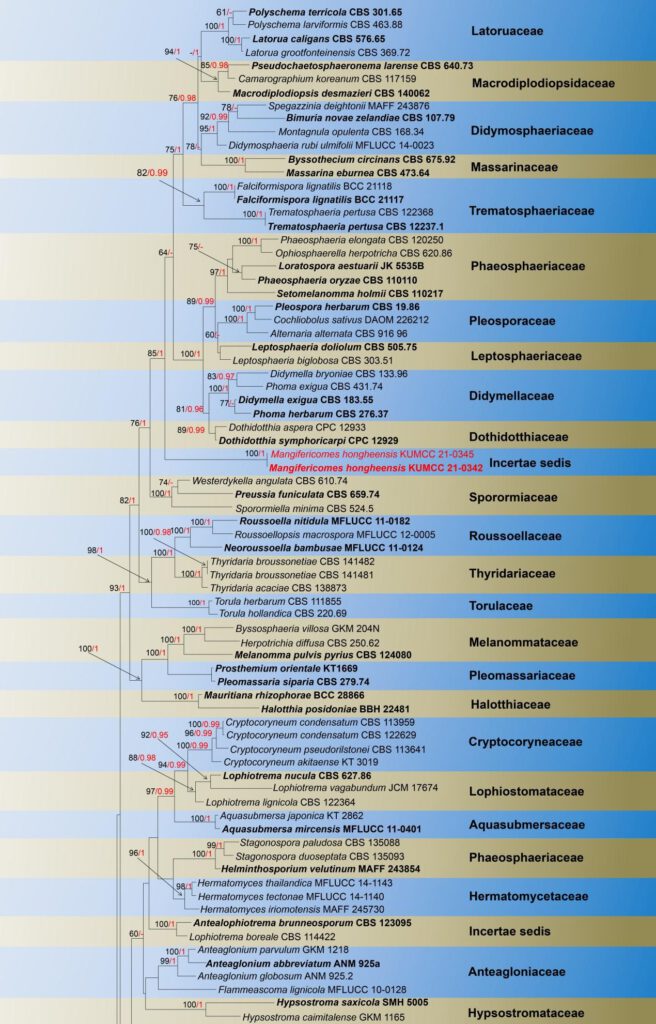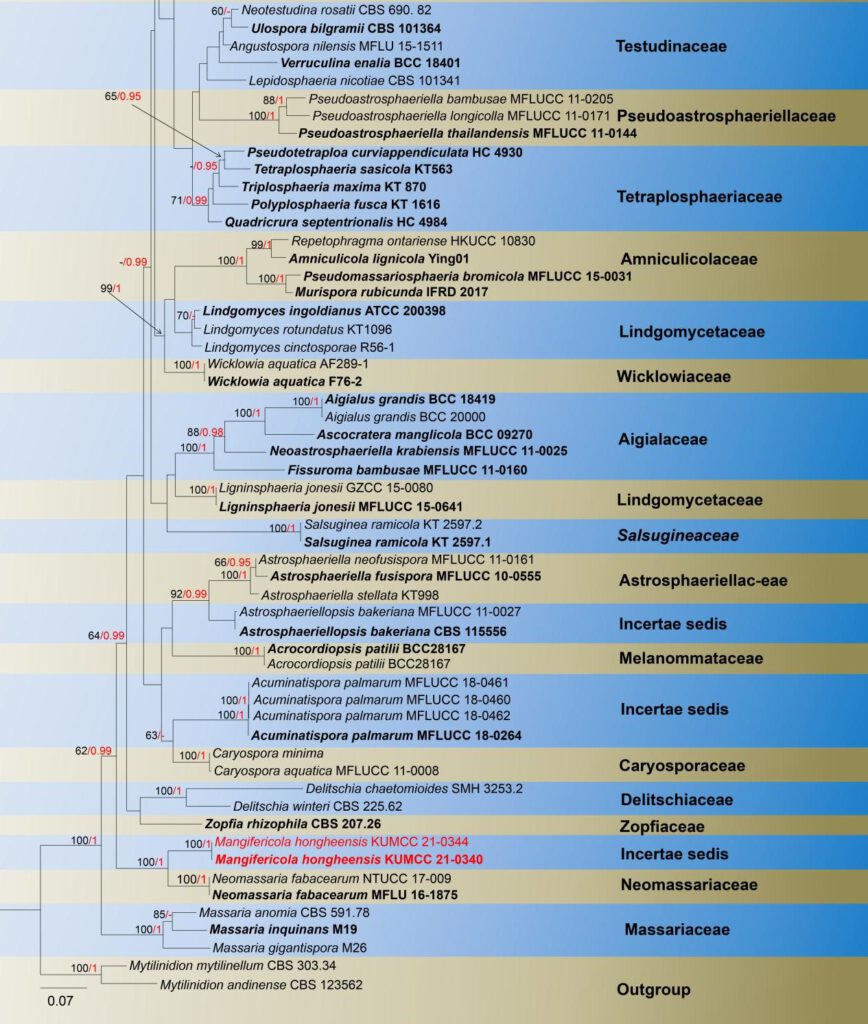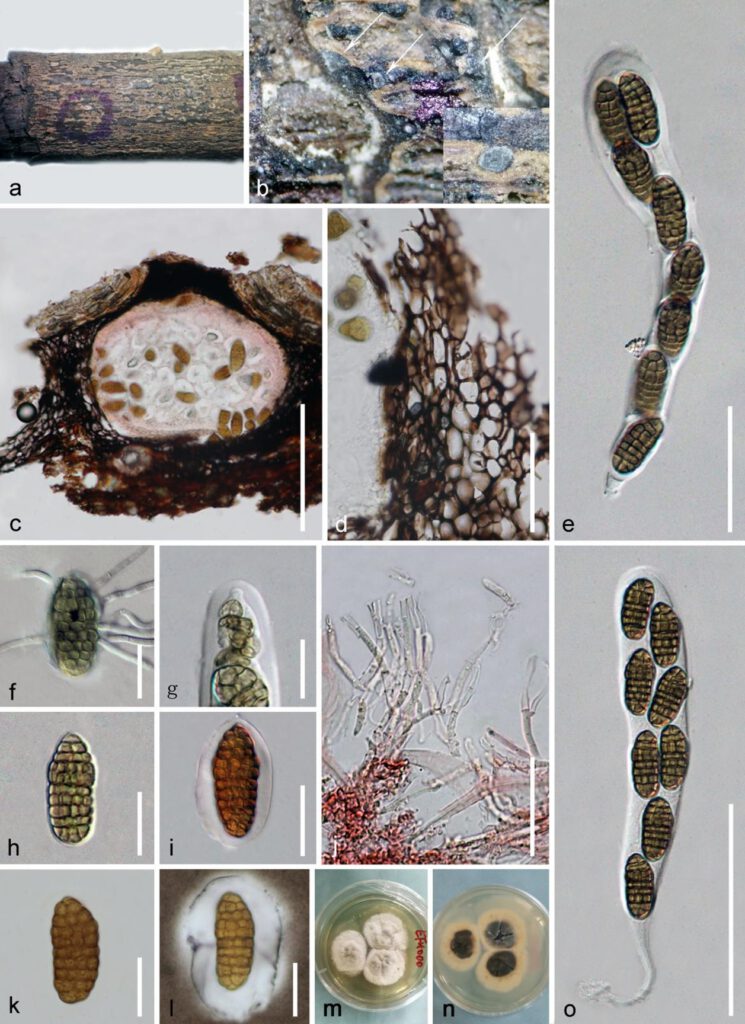Mangifericomes E.F. Yang & S. Tibpromma,, gen. nov
MycoBank number: MB 559283; Index Fungorum number: IF 559283; Facesoffungi number: FoF 10595;
Etymology:—Name reflects which host of holotype was collected, Mangifera indica
Saprobic on dead branches, leaves or wood. Sexual morph: Ascomata immersed or semi-immersed, globose to subglobose, sometime visible apical black neck effuse to host surface, dark brown to black, with or without ostiolate. Peridium comprised by thick, dark brown-walled cells of textura angularis to globosa. Hermathecium comprising filiform, hyaline, thick-walled, septate, branched, with somewhat oil droplets, pseudoparaphyses. Asci 8-spored, bitunicate, cylindrical-clavate, pedicellate, apically rounded with a ocular chamber. Ascospores muriform, ellipsoid, often has one widen apical apart in each, 7–11-transversally septate, and 5–8 longitudinal septum, slightly or strongly constricted at the septa, wrapped by a gelatinous sheath. Asexual morph: Undetermined.
Type species — Mangifericomes hongheensis E.F. Yang & FAI, gen. nov.
Note: The new Mangifericomes was established as a monotypic genus for a fungus associated with Mangifera indica in China, placed in the family Incertae sedis, under the order Pleosporales and Mangifericomes hongheensis KUMCC 21-0342 as type species. Based on morphological examination, our new genus similar with Halojulella avicenniae (Halojulellaceae, Pleosporales) in immersed ascomata, muriform ascospores, with a gelatinous sheath (Ariyawansa et al. 2013) but Halojulella avicenniae can be differ in having dark brown, thick-walled peridium, consisted of textura angularis to globosa cells, ascospore often more obtuse and flat at both ends (6–7 transversally, 2–3 longitudinal VS. 7–11 transversally, and 5–8 longitudinal). Based on phylogenetic analysis shown our isolate distinguish from other species of order Pleosporales.


Fig.X. Phylogram generated from Maximum Likelihood analysis based on a combined LSU, SSU, rpb2 and tef1–α sequence datasets, 132 strains are included in the combined gene analyses 3804 total character including gaps (LSU: 1-859 bp, SSU: 860-1855 bp, rpb2 1856-2880 bp, tef1–α: 2881-3804 bp), Maximum likelihood bootstrap support values greater than 60% are shown in above branches, Tree topology of the ML analysis was similar to the BI. The matrix had distinct alignment patterns, with the final ML optimization likelihood value of -57981.381897 (ln). All free model parameters were estimated by RAxML model, with 2027 distinct alignment patterns and 38.49% of undetermined characters or gaps. Estimated base frequencies were as follows: A = 0.248828, C = 0.242382, G = 0.278083, T = 0.230707, with substitution rates AC = 1.443139, AG = 4.436949, AT = 1.400443, CG = 1.258270, CT = 8.420241, GT = 1.000000. The gamma distribution shape parameter alpha = 0.266642 and the Tree-Length = 9.541896. The final average standard deviation of split frequencies at the end of total MCMC generations calculated as 0.009944 in BI analysis. while Bayesian posterior probabilities greater than 0.95 are in bold. Tree topology of the ML analysis was similar to the BI. type species bold and new isolates in red bold.

Fig. X.–Mangifericomes hongheensis (KUN-HKAS 1221888, Holotype) a. Ascomata on decayed branch of Mangifera indica; b Close up of ascomata on substrate; c Section of Ascomata; d Peridium; e, o Asci; f Germinated ascospore; g Ocular chamber; h, i, k, l Ascospores (i stained with congo red, l stained with india ink). j Pseudoparaphyses. m, n Colonies on PDA. Scale bars: c =150 μm, e, o = 100 μm, d = 50 μm, j = 30 μm, f–i, k, l = 20 μm.
Species
